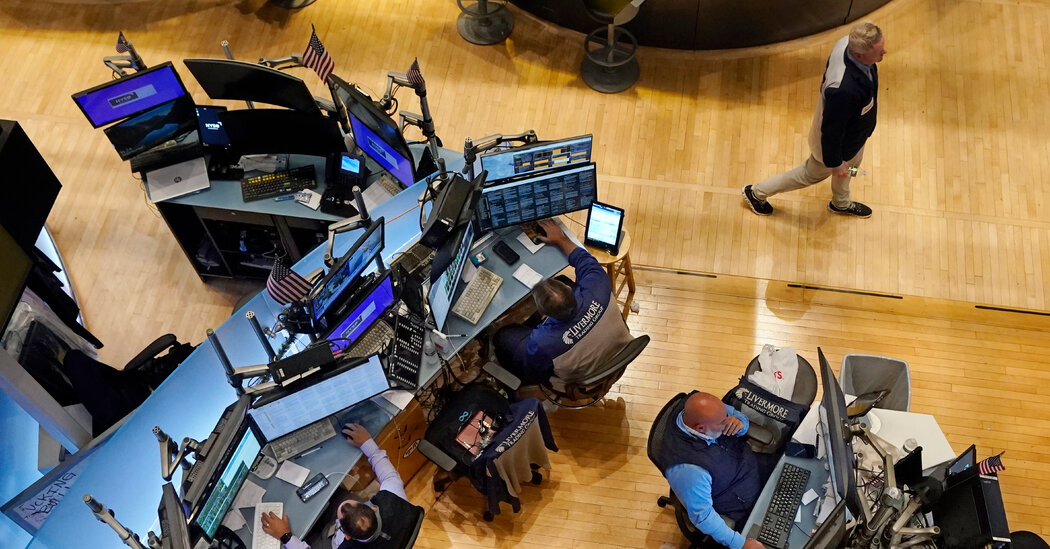After a wild week in the markets that rekindled fears about the strength of the U.S. economy, investors are wondering what comes next.
Until recently, Wall Street was focused squarely on inflation, hoping that its slowdown would lead the Federal Reserve to cut interest rates, giving support to stocks. The recent havoc has added an additional consideration: the risk that markets could tank in response to signs that the economy was slowing too fast.
For now, markets seem to have recovered a sense of calm. The S&P 500 index recorded its biggest gain in nine months on Thursday. It is still on track to end lower for a fourth consecutive week, but only marginally, a significant turnaround after a global rout on Monday.
Investors will be tested in the next few weeks. New data on U.S. inflation is set for release on Wednesday. A week later, Jerome H. Powell, the Federal Reserve chair, is scheduled to give a speech at a marquee economics forum. Wall Street will anxiously await what he says about markets and the economy.
Earnings reports due this month from bellwethers like Walmart will also give hints about the strength of the consumer underpinning the economy, while results from the chipmaker Nvidia will be pivotal given influence of tech giants over the S&P 500.
Investors are braced for potential turmoil.
“We’re not over this yet,” said James Stanley, a senior strategist at StoneX. “We’re not through the woods.”
A similar story is unfolding around the world. In Japan, which bore the brunt of the recent selling, stocks remained volatile but pared losses after their biggest drop since 1987. The Europe-wide Stoxx 600 index enjoyed three days of gains that erased its drop for the week.
Taking a step back, the S&P 500 is up more than 11 percent for the year. For all its short-term ferocity, the magnitude of the recent sell-off since the index peaked in mid-July has not been particularly remarkable, historically speaking. Stocks fell a total of 8.5 percent through the end of Monday. Since 1985, the median sell-off in any given year is around 10 percent, according to Goldman Sachs.
“Pullbacks happen all the time and we think of this as just a pullback,” said Binky Chadha, chief U.S. equity strategist at Deutsche Bank.
Mr. Chadha said he was not lowering his expectation for where the S&P 500 would end the year. “If anything, I would consider raising it,” he said.
In spite of this sober optimism after such a dizzying week, nervousness remains about where the economy could go next, rather than where it is now.
Recent events have cemented expectations that the Fed will cut interest rates in September. When that happens, stocks typically rally. But if the Fed is pushed to cut more aggressively than it had previously expected, it could signal that the economy is under more pressure than the central bank would like.
Goldman Sachs analysts, who also maintained their target for the S&P 500 by the end of the year, wrote that they expected a stock rally as the Fed begins to cut rates, as has typically been the case, “as long as the economy is not on the brink of recession.”
For now, the consensus is that the economy is not yet there. But concerns about the odds of a so-called soft landing have heightened investors’ focus on the big data releases coming up.
The rotation away from big tech companies toward more unloved areas of the financial markets, a sign of broad economic optimism, appeared to be delayed as the dust continued to settle from Monday’s mayhem. The Russell 2000 index of smaller companies, which are more exposed to the economy, has given up most of its gains and sits just 2 percent above where it started in January.
If inflation data disappoints next week, for example, “that could spark more of those recession fears,” said Mr. Stanley.
And if the fundamental strength of the economy holds for now, there are other worries looming on the horizon — like the acrimonious U.S. presidential election or rising tensions in the Middle East — as well as more technical reasons that the stock market could continue to wobble.
Even market bulls are girding for a period of turmoil.
“I would not be surprised if equities remain in a bit of a funk for a while,” Mr. Chadha said.




For applications in corrosive environments, Elite Pipe Factory offers titanium pipes that provide unmatched strength and resistance. These pipes are ideal for industries requiring superior performance under harsh conditions. Our dedication to quality makes Elite Pipe Factory a leading choice in Iraq for titanium pipes. Discover more about our products at elitepipeiraq.com.
Bwer Company is a top supplier of weighbridge truck scales in Iraq, providing a complete range of solutions for accurate vehicle load measurement. Their services cover every aspect of truck scales, from truck scale installation and maintenance to calibration and repair. Bwer Company offers commercial truck scales, industrial truck scales, and axle weighbridge systems, tailored to meet the demands of heavy-duty applications. Bwer Company’s electronic truck scales and digital truck scales incorporate advanced technology, ensuring precise and reliable measurements. Their heavy-duty truck scales are engineered for rugged environments, making them suitable for industries such as logistics, agriculture, and construction. Whether you’re looking for truck scales for sale, rental, or lease, Bwer Company provides flexible options to match your needs, including truck scale parts, accessories, and software for enhanced performance. As trusted truck scale manufacturers, Bwer Company offers certified truck scale calibration services, ensuring compliance with industry standards. Their services include truck scale inspection, certification, and repair services, supporting the long-term reliability of your truck scale systems. With a team of experts, Bwer Company ensures seamless truck scale installation and maintenance, keeping your operations running smoothly. For more information on truck scale prices, installation costs, or to learn about their range of weighbridge truck scales and other products, visit Bwer Company’s website at bwerpipes.com.